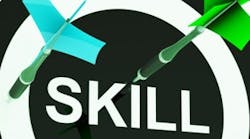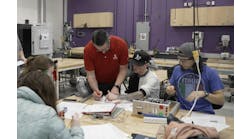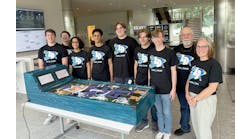Automation's Got Talent: STEM Programs Supply Rookie Engineers to Replace Retiring Veterans
Jim Montague is the executive editor for Control. Email him at [email protected].
Just like everyone else, Arpac couldn't find enough qualified engineers. Three years ago, the packaging machine builder and services firm in Schiller Park, Illinois, recruited, advertised, networked and posted available positions online, but all it got was a limited and inadequate response.
"We were doing all we could to recruit through the usual channels," says Howard Dittmer, vice president of engineering and technology at Arpac. "We even put a billboard up on the expressway, but that didn't work either. It could take a year for us to fill an engineering job. Finding engineers has become really difficult, so we decided to keep our traditional recruiting methods, but also develop some new ones.”
This problem is common and widespread for machine builders, system integrators, control and automation suppliers, as well as their clients and end users in manufacturing companies almost everywhere.
Even though everyone talks about the need to replace all the veteran engineers, technicians and operators retiring in the U.S., Europe and elsewhere, it can seem like no one's doing anything about developing the next generation of rookies needed to do it. The usual opinions are that young people only want to be sports and rock stars; they think factories are dirty; and they don't want to take all the math and science courses needed to become engineers.
"Mid-skilled engineering technicians are in shortest supply, but it's been hard to get kids interested in these professions,"says Chris Paynter, dean of science, technology, engineering and math (STEM) at Central Piedmont Community College in Charlotte, North Carolina. "Employers say this interest gap is real, production suffers, and it prevents their companies from growing. "By combining many of its math, science, engineering and IT sections, the college established its innovative, multidisciplinary STEM operating unit in 2009.
Also Read: The Kids Are All Right: Producing Rookie Engineers From STEM Programs
Plugging the Drain
While the Baby Boom brain drain is genuine, the perceived lack of solutions is fiction. There are plenty of high school and college students, recent graduates and mid-career workers looking to switch careers—and most are willing to learn and train. Many community college, university and high school programs teach automation and control skills, and many manufacturers conduct apprenticeship and training programs to develop the technical professionals they desperately need. Some colleges and companies are coordinating their efforts to refine curricula and focus more effectively on getting the best and most needed skills instilled in students quickly.
To give students technical instruction that has more of a point, STEM programs such as FIRST Robotics are multiplying nationwide. This is because STEM gives kids the same sense of purpose and accomplishment that veteran engineers have long reported valuing even more than good salaries.
"Robotics programs like FIRST are a lot more hands-on,"says Adrian Choy, associate field services engineer at Rockwell Automation, who works onsite with metalworking clients, most recently on controlling their chemical treating lines. "When you design, test and build a robot that has your name on it, you have more of a sense of pride. You want to do better, especially at an event where you're competing in front of a cheering crowd. That's encouragement above and beyond a regular class.”
Choy graduated from Chicago's Whitney Young High School in 2007, where he participated in FIRST and its different robotic challenges. He earned a bachelor's degree in mechanical engineering from the University of Michigan in 2012, where he participated in the Association for Unmanned Vehicle Systems Int'l's RoboBoat navigation and other competitions for two years. "Solutions to classic mechanical problems might look good on paper in a class, but if you don't take actual tolerances into account, then you're going to have serious problems," Choy says. "That's what we learned in FIRST. I work on a lot of mechatronic systems now, and we often have to find out if we're dealing with a programming error or a hardware error. Real-world forces usually require multidisciplinary skills, judgment and solutions, and FIRST teaches this as well.”
To bring STEM principles even closer to the controls field, Phoenix Contact established its Nanoline Contest in 2008-09. Middle, high school and college students use its mini-PLC controllers and software to program robots and equipment to complete a variety of tasks. Thirty teams signed up for the 2014 competition, 17 teams competed in two regional contests, and a team from Walker Career Center in Indianapolis won with its RoboDose automated, medical-pill-dispensing machine.
Unfortunately, these education, training and STEM programs just scratch the surface of what's needed to break the intensifying drought of experienced engineers and technicians. Many more academic programs are required, and they'll need to be much more closely integrated with manufacturers' factory-floor needs to be effective and successful.
Active Involvement = Successful Recruiting
To boost its own recruitment efforts, Dittmer says Arpac is at work on several additional fronts. "We started bringing in interns and sending our engineering managers, supervisors and HR staff to more job fairs at nearby colleges and universities, such as Purdue, Northwestern, Wisconsin and the Rose-Hulman Institute of Technology," he said. "However, we've also learned that we have to be careful about what programs we recruit from because some are too theoretical, and we need people who've had more practical instruction and have a strong, hands-on work ethic.”
Dittmer adds that Arpac has paid interns, with three or four more added in the summer—typically college sophomores who learn increasingly challenging tasks. "We give them as much responsibility as they can handle, and when they master one skill we give them another," Dittmer explains. "They do everything from drafting to changing gearboxes, which means they investigate required strengths, evaluate bolt patterns and then change out the hardware.”
Figure 1: Chris Gioiosa, who just graduated from Purdue University Calumet with a degree in electrical engineering, adjusts the controls on his Shot-O-Matic automated liquid dispensing system, which combines a programmable HMI, ladder logic, stepper motor and linear servomotor.
Back to School
Of course, the best way for machine builders and manufacturers to secure new engineers and technicians is to work with their local community colleges, universities and high schools. For example, some of Arpac's interns and recent hires came from Purdue University Calumet in Hammond, Indiana, which offers a Mechatronics for Packaging program.
The program is chaired by Nick Wilson, CEO of Morrison Container Handling Solutions in Glenwood, Illinois, and it uses federally recognized testing and certification input on PLC programming, electronic troubleshooting and other skills from PMMI, the Association for Packaging and Processing Technologies.
"This is a four-year program that focuses on the needs of packagers and packaging machine builders, so it's more practical, job-oriented and modeled on the German principle of ‘fachhochshule,' which translates as ‘a university of applied sciences," says John Kowal, business development director at B&R Industrial Automation, and member of the dean's executive council at Purdue Calumet. "These programs are especially useful because they give students a chance to learn about machine builders before working for them, and companies get to see the potential that the students possess. It's hard to let students know about careers, good salaries and growth potential in engineering and technical fields, but this is one of the best ways to do it.”
Likewise, Chris Gioiosa just graduated from Purdue Calumet with a degree in electric engineering, but he's already been working for about seven months for Advanced Technology Services (ATS) in Schaumburg, Illinois, which provides automated factory maintenance. Before graduating in May, Gioiosa and fellow students presented senior projects at Purdue Calumet's Tech Day. Gioiosa designed and built a "Shot-O-Matic" automated liquid dispensing system that combines a programmable HMI using ladder logic, a 24-20 V power supply, 24-30 V stepper and a linear servo with 25 lbs thrust (Figure 1).
"I wanted to automate the process of bringing glasses to a beverage holder, so I took the turntable hardware out of a lazy Susan, added a base plate with the stepper motor, and then used the linear servo to push the table with the glasses into position," Gioiosa explains. "I also had to figure out that the stepper generated 30,000 pulses for one full revolution, so increments of 5,000 pulses would move it to each of six positions.”
Arpac's ties to the university have grown strong enough that the machine builder is represented on Purdue Calumet's committees. "Relationships with community colleges and universities are very important, but you have work at it," Dittmer says. "So far, we've hired six fresh mechanical engineering grads in the past three years. We wanted the best graduates we could find, and we're very happy with the ones we got."
Continuing Education
The story doesn't end with successful hiring because training and education keep right on going. "We keep the challenges coming—along with more opportunities to grow and be recognized," Dittmer adds. "We have an awards dinner each year at the Museum of Science and Industry in Chicago because we know that celebrating our engineers and their significant others is very powerful too.”
Paynter reports that CPCC's STEM department leverages expertise from multiple disciplines for more dynamic learning. Its students complete robotics projects, host FIRST Robotics teams and participate in human-powered vehicle contests. There's also more specialized instruction for students to learn automation from the IEEE Robotics and Automation Society or mechatronics from Skills USA.
Local, regional and national science, technology, engineering and math (STEM) programs for young people of all ages (and their teachers) are multiplying in number and variety, but many more are needed. Here are some of the most significant U.S. programs:
Association for Unmanned Vehicle Systems Int'l is a non-profit organization devoted to advancing the unmanned systems and robotics community.
- For Inspiration and Recognition of Science and Technology, (FIRST, www.usfirst.org) has four main components: FIRST Robotics Competition for grades 9-12, FIRST Tech Challenge for grades 7-12, FIRST Lego League for grades 4-8, and Junior FIRST Lego League for kindergarten to 3rd grade. It has 3,500 sponsors and 130,000 volunteers.
- IEEE Robotics and Automation Society strives to advance innovation, education, and fundamental and applied research in robotics and automation.
- Project Lead the Way (www.pltw.org) is a school-based, multi-disciplinary STEM program that stresses collaboration and problem solving in more than 5,000 U.S. schools.
- Skills USA is a partnership of students, teachers and industry working to make sure the U.S. has a skilled workforce. It's also a member of WorldSkills Int'l.
- SmartAmerica Challenge is a joint effort by industry, academia and government to show how cyber-physical systems can create jobs, new business opportunities and socio-economic benefits.
- UTeach Institute teaches K-12 teachers about STEM topics at 40 universities nationwide.
- Vex Robotics is a design system and robotic kit that introduces robotics to middle and high schools. Vex competitions include more than 4,800 teams from 20 countries in over 300 tournaments worldwide.
"Other community colleges divide subjects such as math into college-level courses with students transferring credits to four-year colleges and applied courses with students learning skills to make them job-ready or prepare them for other courses like electrical engineering," Paynter explains. "We put all our math into one department, which gives our curriculum more hands-on, real-world examples of how math is used in manufacturing, energy and engineering. Likewise, our STEM department lets us identify students' interests and lay out broad disciplines, so they can follow their passions and find careers they want, or pivot to the right job. I see STEM as a brand that can strip away science and math's old, stodgy environment, and make them fun, attractive and approachable. So if you're good at science and math, STEM shows how they can be used in creative ways.”
Partnerships, Internships and Apprenticeships
Historically, students went to vocational and technical schools for a few years and then were hired and trained by companies for several more months or years. More recently, many STEM education programs and their industrial partners try to compress this process, so companies can get trained staff faster.
Paynter reports some of CPCC's machinists recently were hired by Bosch Rexroth in Charlotte, North Carolina, which created its own apprenticeship program, but then arranged for the college to run it. Logically, more apprenticeship programs are being run in conjunction with—and even at the same time as—the STEM programs from which they're hiring. This allows STEM students to get a technical education, get hired, paid and learn about the firms where they'll work.
"We have a long history with apprenticeships, but it's an idea that's regaining traction now, especially among German firms in our area,"Paynter says. "The idea is that companies hire students and make long-term investments in them by paying tuition and a wage. In our program with Bosch Rexroth, they go to college one or two days a week, work at Bosch three of four days a week and complete their education in one to four years, depending on the skills they need.”
In fact, almost 20 years ago, two German companies with facilities in the Charlotte area, Blum and Daetwyler, started their Apprenticeship 2000 program to train high school graduates as tool-and-die makers, CNC machinists, welding fabricators and electronics, machine and mold/plastics technicians. This four-year program pays salary and tuition, and teaches at CPCC and at firms where its participants are hired. Since its initial start-up, six more companies have joined Apprenticeship 2000 to teach future workers.
"Apprenticeship 2000 was a great opportunity for me to jump into the workforce and establish a career while earning a college degree," says Trevor Seifts, electrical controls technician at Daetwyler. "Working with Daetwyler, I gained valuable experience, and I earned a college degree in electrical engineering (EE). Plus, I was paid for time at work and school, as well as having my tuition and books taken care of by Daetwyler. I started out in the program with the mechanical pathway in mind, but after a year I found my drive was towards electronics. So I was able to study in the EE program at CPCC, join Daetwyler's engineering department and establish myself there as an electrical controls technician.
I've also had the chance to work on new and exciting projects, such as micro-waterjet technology. This included traveling to Switzerland for three-and-a-half months and learning everything from research and development to assembly, machine installation, and designing a process control system to interface with the machines. I'm also fortunate to be part of an experienced team that specializes in custom controls and machine design. Finally, I was welcomed as part of the Daetwyler safety team recently, and I look forward to integrating into that team and gaining more valuable experience."
Sparking Minds
Beyond increasing their immediate hiring needs, more machine builders and other manufacturers are waking up to the need to develop and train potential talent for the longer term. For many, this means cooperating with local high, junior high and elementary schools to offer STEM enrichment programs and sponsoring and/or mentoring FIRST Robotics and other competitive teams. Also, many manufacturers conduct tours and open-house events for local kids and parents just to let their communities know what kind of work their technically specialized neighbors do—and maybe clue in a few youngsters that good-paying jobs are available.
"Guidance counselors tell kids who are good at math and science to go into engineering, but they don't give them a reason why or how to do it," Dittmer adds. "So, much of STEM's outreach is to educate students, teachers and parents about what engineering actually is."
Figure 2: Maximillian Hill, who just graduated from Niles North High School, programs a Haas TM1P CNC mill in the school’s STEM Lab.
To increase that awareness, Niles North High School in Skokie, Illinois, offers seven Project Lead the Way courses in introductory engineering, computer integrated manufacturing and other types of engineering, which all culminate in AP exams with transferable college credits. It and sister school, Niles West, are reportedly two of only three high schools in the U.S. that offer a girls-only engineering class, which has been shown to draw girls into fuller participation in the curriculum compared to co-ed math and science classes. Niles North also offers a robotics course in summer, and its Engineering Club participates regularly in Vex Robotics competitions using Robot C and Easy C software.
Over the past few years, the teachers in Niles North's STEM Lab have written state, federal and business grants, and gathered an impressive collection of machining centers, including three CNC horizontal lathes, two CNC mills, one CNC router and a 3D printer. The mills are from Haas Automation in Oxnard, California, which offers its machines at extremely low prices to schools and colleges to encourage their STEM programs (Figure 2). The students also are taught to use Autodesk Inventor software to design projects and Mastercam software to model them for translation into the G and M code that will run the machines.
"When I was in college in 2000 at Purdue and Illinois State universities, we had one old Cincinnati mill and one CNC machine, and the rest of the equipment was manual," says Benjamin Brzezinski, engineering teacher at Niles North. "The machines we have here are much better because they give students real, hands-on experience and expose them to a whole different world. We get calls all the time from tool and die manufacturers, who want to hire our students as interns and for possible full-time employment later. Manufacturing makes up about 20% of our gross domestic product (GDP), but there are about 3 million jobs unfilled in the U.S. because people don't have the skills. Our task is to get students ready for those jobs.”
Teaching Teachers, Mentoring Mentors
Ironically, an unexpected, but equally important, benefit of STEM education and training rookies is that they can bring fresh and valuable perspectives to their new organizations and veteran colleagues too. To maximize benefits in both directions, Bosch Rexroth recently set up a STEMersion program, a two-week summer camp for teachers in Raleigh, N.C. This year's camp has 50 teachers who make half-day visits to about 20 local manufacturers, which will help them tailor instruction to the skills that businesses seek. "The teachers can go back and tell their students that the Pythagorean Theorem is used on CNC machines every day,"says Mark Rohlinger plant technical manager at Bosch Rexroth.
"Bringing in a student for a semester isn't expensive, and your company likely will get as much out of the experience as the student," Dittmer believes. "Our interns got small projects done that our regular staff didn't have time for. And any time you get a new person in, they're going to see problems that we've been looking at for a long time with new eyes and a new perspective. And they often can come up with very good solutions.”
Though STEM is primarily for young people, its principles can be applied over entire lifetimes, according to Arnold Offner, industry standards manager at Phoenix Contact. "STEM shouldn't just end at high school and college," says Offner. "It should be ongoing and lifelong for everyone because we all encounter new technologies that we're going to have to learn and gain new skills to keep up with."







